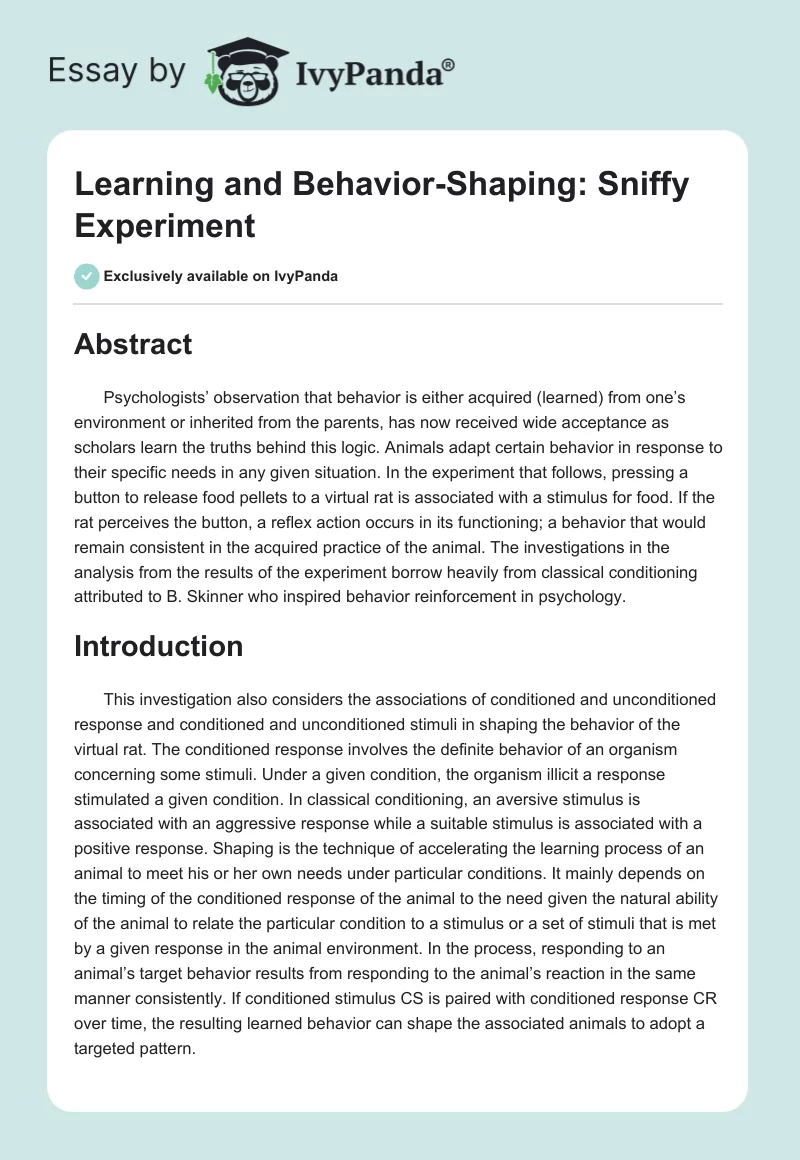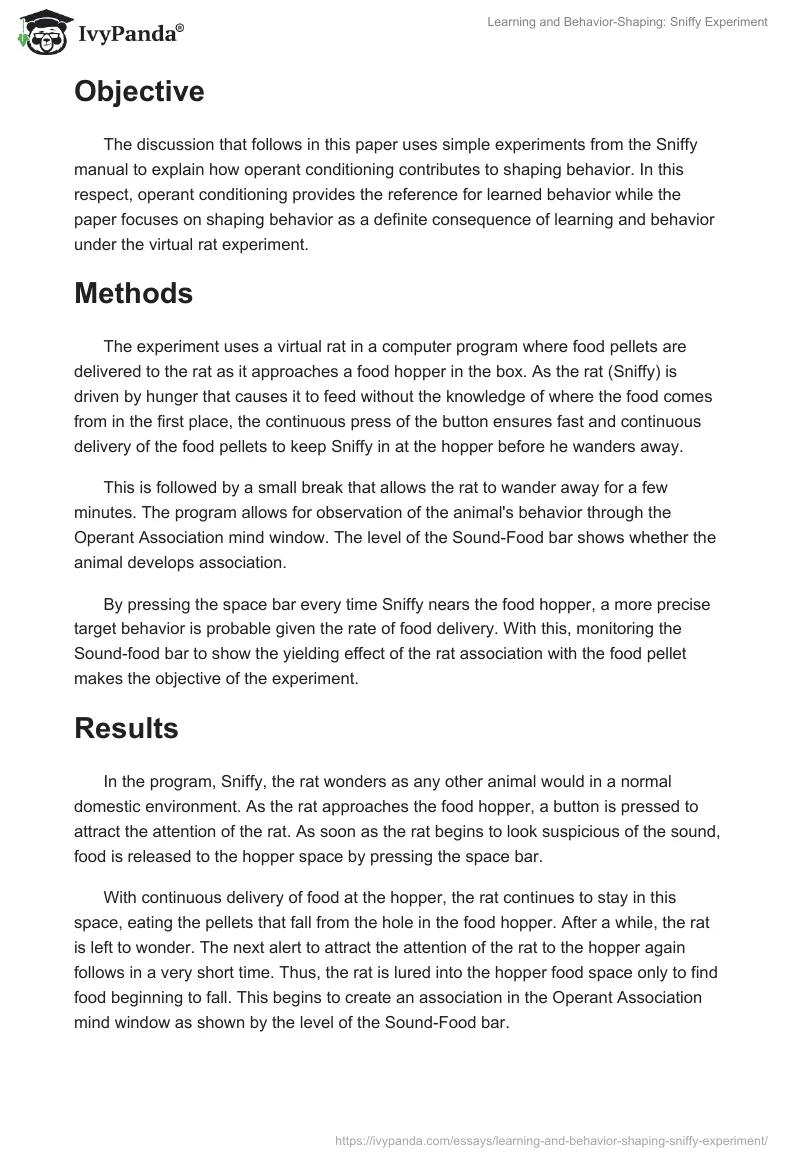Abstract
Psychologists’ observation that behavior is either acquired (learned) from one’s environment or inherited from the parents, has now received wide acceptance as scholars learn the truths behind this logic. Animals adapt certain behavior in response to their specific needs in any given situation. In the experiment that follows, pressing a button to release food pellets to a virtual rat is associated with a stimulus for food. If the rat perceives the button, a reflex action occurs in its functioning; a behavior that would remain consistent in the acquired practice of the animal. The investigations in the analysis from the results of the experiment borrow heavily from classical conditioning attributed to B. Skinner who inspired behavior reinforcement in psychology.
Introduction
This investigation also considers the associations of conditioned and unconditioned response and conditioned and unconditioned stimuli in shaping the behavior of the virtual rat. The conditioned response involves the definite behavior of an organism concerning some stimuli. Under a given condition, the organism illicit a response stimulated a given condition. In classical conditioning, an aversive stimulus is associated with an aggressive response while a suitable stimulus is associated with a positive response. Shaping is the technique of accelerating the learning process of an animal to meet his or her own needs under particular conditions. It mainly depends on the timing of the conditioned response of the animal to the need given the natural ability of the animal to relate the particular condition to a stimulus or a set of stimuli that is met by a given response in the animal environment. In the process, responding to an animal’s target behavior results from responding to the animal’s reaction in the same manner consistently. If conditioned stimulus CS is paired with conditioned response CR over time, the resulting learned behavior can shape the associated animals to adopt a targeted pattern.
Objective
The discussion that follows in this paper uses simple experiments from the Sniffy manual to explain how operant conditioning contributes to shaping behavior. In this respect, operant conditioning provides the reference for learned behavior while the paper focuses on shaping behavior as a definite consequence of learning and behavior under the virtual rat experiment.
Methods
The experiment uses a virtual rat in a computer program where food pellets are delivered to the rat as it approaches a food hopper in the box. As the rat (Sniffy) is driven by hunger that causes it to feed without the knowledge of where the food comes from in the first place, the continuous press of the button ensures fast and continuous delivery of the food pellets to keep Sniffy in at the hopper before he wanders away.
This is followed by a small break that allows the rat to wander away for a few minutes. The program allows for observation of the animal’s behavior through the Operant Association mind window. The level of the Sound-Food bar shows whether the animal develops association.
By pressing the space bar every time Sniffy nears the food hopper, a more precise target behavior is probable given the rate of food delivery. With this, monitoring the Sound-food bar to show the yielding effect of the rat association with the food pellet makes the objective of the experiment.
Results
In the program, Sniffy, the rat wonders as any other animal would in a normal domestic environment. As the rat approaches the food hopper, a button is pressed to attract the attention of the rat. As soon as the rat begins to look suspicious of the sound, food is released to the hopper space by pressing the space bar.
With continuous delivery of food at the hopper, the rat continues to stay in this space, eating the pellets that fall from the hole in the food hopper. After a while, the rat is left to wonder. The next alert to attract the attention of the rat to the hopper again follows in a very short time. Thus, the rat is lured into the hopper food space only to find food beginning to fall. This begins to create an association in the Operant Association mind window as shown by the level of the Sound-Food bar.
When the height of the Sound-Food bar in the association space rises beyond three-quarters, it is worth noting that the rat is developing a considerable association between the sound of the hopper and the food pellets. Thus, the hoppers sound can be used to reinforce the rat’s behavior. At this point, Sniffy’s manual is valid and the saved file is fit for the experiment analysis (Powell, Symbaluk, & Lynne, 2008, p. 105).
The closer the timing between the hopper sound and the food pellets delivery, the faster the rate of developing the association. When the rat is left to wander in the box for a long time before the next sound alert, it is followed by an apt response in the next sounding of the hopper that is accompanied by rapid feeding in the hopper space.
Discussion
The consistency in introducing food pellets to the virtual rat at each instance of a bell that is associated with stimuli for hunger ideally reinforces the animal behavior to elicit the same response each time the bell rings.
The trainer progressively introduces the learner to target behavior following simple steps methods. After every stage, the trainer withholds the reinforcement to monitor the progress of the animal (Powell, Symbaluk, & Lynne, 2008, p. 105).
The time-lapse occurring between the points where the animal stopped receiving the reinforcement and the next stage when the reinforcement is re-introduced provides the window for assessing the animal’s ability to adjust to the environmental response to its behavior.
Since the experiment is intended to make the rat learn how to tap and press the button that releases food pellets, pairing the sound of the food hopper and food pellets in the same proximity, significantly yields the desired behavior. Shaping Sniffy’s feeding behavior is thus achieved through the habitual feeding mode of the rat as in the case of classical conditioning (Alloway & Krames,1994. p. 137).
In the second stage, reinforcing the desired behavior to tame (shape) the animal’s behavior toward the independent practice of the newly introduce style of obtaining food follows through varying the time difference between hopper sounds.
In the third and subsequent stages, reinforcement then targets mainly the animal’s movement behavior that seeks to make it more regulatory in adjusting to the hopper conditioning. As in classical conditioning, the sound of the hopper stimulates the rat’s hunger, and then it elicits a response that prompts it to move toward the hopper where its stimuli are met by ready food.
Over time, the rat is conditioned to respond to the hopper sound in a similar way. In this way, its conditioned stimuli are associated with a conditioned response as the food pellets never fail to land on its space if the rat assumes a certain position. The likelihood of the rat entering the hopper food space to commence eating in the position that allows more pellets to fall to it until he eats to his satisfaction would eventually result in the rat adapting the habit of leaning to press the button (Alloway & Krames,1994. p. 135).
Conclusion
Sniffy’s experiment used in this investigation for shaping animal behavior is effective in many ways; For example, in the manner in which it chooses the behavior fit for shaping, feeding like drinking would be agitated by an external activity that causes an animal to elicit a response followed by specific stimuli that push the animal into action. If the action results in a positive feedback, like food pellets in the case of Sniffy, reinforcement of the behavior following the pairing of the CS and the CR yields the behavior desired. Nonetheless, like in classical conditioning and Pavlovian experiments, shaping is achieved through closing the gap between the sound and the response, thus when the sound rings the animal codes the particular pleasant or aversive response.
Reference List
- Alloway. G. J., Krames L.1994. Sniffy, the virtual rat: Simulated operant conditioning. Behavior Research Methods, Instruments, & Computers. 26:134–141.
- Powell, R. A., Symbaluk, D. G. & Lynne. H. P 2008. Introduction to Learning and Behavior (3rd ed.). Belmont: Cengage Learning. p. 105


